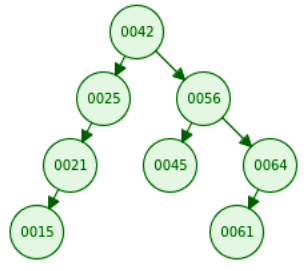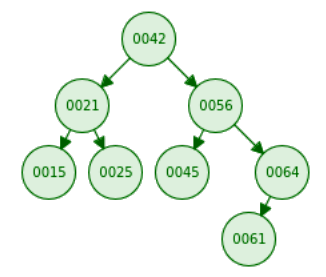 In this problem you should only submit a binarySearchTree.h file with a self-containing definition of a class BinarySearchTree<T>
In this problem you should only submit a binarySearchTree.h file with a self-containing definition of a class BinarySearchTree<T>In what concerns the continuous evaluation solving exercises grade during the semester, you should submit until 23:59 of December 7th
(this exercise will still be available for submission after that deadline, but without couting towards your grade)
[to understand the context of this problem, you should read the class #08 exercise sheet]
 In this problem you should only submit a binarySearchTree.h file with a self-containing definition of a class BinarySearchTree<T>
In this problem you should only submit a binarySearchTree.h file with a self-containing definition of a class BinarySearchTree<T>
Use as a basis the class BinarySearchTree<T> (see code | download code) which implements a generic binary search tree that was given in the classes, with methods to read insert, remove and check of a value exists, to write a preOrder traversal with N as null nodes and the number of nodes and height of the tree.
Add a new method bool isAVL() to the class. The function should return true if the search tree is an AVL tree and false otherwise. Recall that the tree is an AVL tree if it is a search tree and for all its nodes the (absolute) difference between the heights of the right and left branches is at most 1.
You can be assured that tree is a binary search tree, because it will be built using sucessive calls to the insert method.
You should submit the file binarySearchTree.h with the method isAVL added to binarySearchTree<T> as requested (and without removing any of the other existing methods). You can however create additional methods, if you need them.
Mooshak will use the following code to link to your class, read the inputs, build the trees and call your method, printing its result.
#include <iostream> #include <string> #include "binarySearchTree.h" int main() { BSTree<int> t; // Read tree by inserting numbers int n; std::cin >> n; for (int i=0; i<n; i++) { int x; std::cin >> x; t.insert(x); } // Call method to check if tree is an AVL Tree std::cout << "t.isAVL() = " << (t.isAVL()?"true":"false") << std::endl; return 0; }
| Example Input 1 | Example Output 1 |
8 42 25 56 21 45 64 15 61 |
t.isAVL() = false |
Explanation of Example Input 1
The tree of the example input 1 corresponds to the following figure:

| Example Input 2 | Example Output 2 |
8 42 21 56 15 25 45 64 61 |
t.isAVL() = true |
Explanation of Example Input 2
The tree of the example input 2 corresponds to the following figure:
